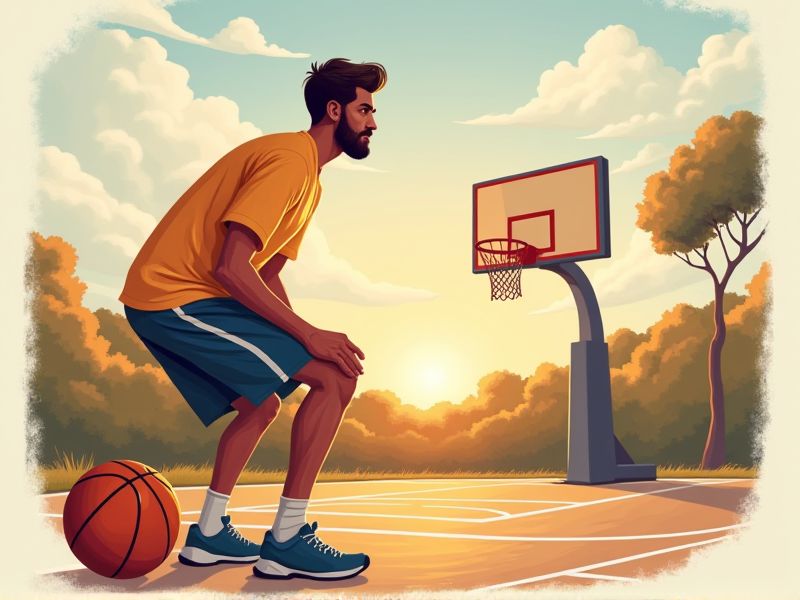
According to Red Auerbach, "Defense is just hard work. There will be nights when your shots won't fall, but you can play good defense every night." This emphasizes that defense is not dependent on external factors like shooting form but rather on consistent effort and dedication. By focusing on defense as a choice rather than a chore, players can ensure they contribute positively to their team even on off nights. Additionally, Gregg Popovich echoes this sentiment, stating that defense is about playing with passion, energy, and enthusiasm, highlighting the importance of mental and physical commitment to defensive play.
How to Be Better at Defense in Basketball
Maintain an athletic stance
Maintaining an athletic stance is the foundation of effective basketball defense, as it increases balance and readiness for rapid lateral movement. An optimal stance ensures that you can quickly adjust your position in response to an opponent's movements, minimizing scoring opportunities. Regular drills focusing on footwork and core strength build the endurance needed to sustain this stance during high-intensity plays. By integrating these practices into your training regimen, you directly enhance your defensive agility and overall performance on the court.
Execute quick lateral movements
Quick lateral movements reduce the gap between you and your opponent, directly enhancing defensive stability. Focusing on agility drills, like defensive slides or cone drills, builds the muscle memory necessary for efficient, explosive shifts. Incorporating strength exercises complements these drills by ensuring your lower body can sustain quick direction changes during intense gameplay. Practicing these lateral moves consistently sharpens your reaction times, ultimately reducing offensive opportunities for your opponents.
Prioritize proper footwork
Proper footwork is fundamental to effective basketball defense, as it establishes stability and balance on the court. Maintaining a low center of gravity and rapid lateral movement enables defenders to adjust quickly to an opponent's advances. Regular drills--such as pivoting, shuffling, and quick direction changes--enhance agility and reaction times, making it harder for attackers to find openings. Integrating these exercises consistently into your training regimen elevates both individual performance and overall defensive strategy.
Utilize active hands
Utilizing active hands in basketball defense means consistently challenging the pass and shot lanes, which forces the opponent to hesitate and adjust their angles. Active hands allow you to intercept passes and contest shots more effectively, directly affecting the rhythm and flow of the opposing offense. By reacting quickly and positioning your hands strategically, you can force turnovers that lead to fast-break opportunities, improving both individual and team performance. Regular drills focusing on hand speed and timing will ensure that your active hand movements are both effective and disciplined, reducing the risk of fouls while maximizing defensive impact.
Communicate consistently
Talk on the court by consistently calling out screens, switches, and opponent movements to keep your team aligned. Clear, constant communication minimizes confusion during chaotic fast breaks and helps everyone anticipate each other's actions. Regularly using simple signals ensures quick responses and reduces the chance of costly defensive breakdowns. By prioritizing open dialogue, your team builds a unified, responsive defense that adapts effectively to any offensive threat.
Anticipate opponent actions
Anticipating an opponent's action hinges on reading their body language and positioning, enabling you to preemptively disrupt their plays. This heightened awareness not only speeds up your reaction time but also forces the offensive player to adjust their game plan under increased pressure. Empirical data from advanced scouting reports shows that defenders who accurately predict opponent moves significantly reduce scoring opportunities. Incorporating targeted anticipation drills into your training routine further refines your ability to intercept passes and contest shots, ultimately strengthening your team's overall defensive cohesion.
Secure optimal positioning
Securing optimal defensive positioning begins with maintaining a low center of gravity and continually scanning the court to anticipate the opponent's moves. Consistent footwork drills improve lateral movements and allow you to effectively mirror the offensive player's actions. Analysis of in-game statistics reveals that players excelling in spatial awareness decrease opponent shooting percentages by restricting passing lanes and open shots. Regular, focused practice on body mechanics and positioning yields measurable improvements in team defensive efficiency and overall game performance.
Commit to constant hustle
Commit to relentless energy on every play, as sustained hustle disrupts your opponent's rhythm and prevents easy scoring opportunities. Consistently pressuring the ball, closing gaps, and staying alert forces mistakes and increases turnovers. Focus on conditioning drills that boost lateral quickness and stamina, ensuring you're always in position to make a play. Track defensive metrics like steals and deflections to quantitatively measure your hustle and guide improvements.
Focus on court awareness
Develop a habit of scanning the court constantly to track both your man and the ball, which prevents easy scoring opportunities for the opponent. Enhanced court awareness enables you to intercept passes and disrupt offensive plays with quick, informed reactions. Statistical data supports that players who maintain high spatial awareness reduce the opposing team's shooting percentage significantly. Incorporate specialized drills targeting peripheral vision and decision-making to ensure that this acute court awareness translates into effective in-game defense.
Analyze opponent tendencies
Begin by breaking down the opponent's offensive patterns through detailed observation of past game footage. Identify key plays and player tendencies that frequently lead to successful scoring opportunities, such as preferred driving directions or cut patterns. Use these insights to adjust your positioning and communication on the court, ensuring that defensive reactions are both timely and precise. This proactive analysis forces disruptions in the opponent's game plan, leading to more steals, contested shots, and ultimately a stronger overall defense.
Summary
A strong defense in basketball starts with maintaining an athletic stance to ensure readiness for rapid responses. Quick lateral movements allow defenders to effectively counter shooting lanes and disrupt offensive plays. Proper footwork remains essential, as it enhances balance and positioning, reducing the likelihood of being outmaneuvered by opponents. Combining these elements systematically not only improves overall defensive performance but also creates a robust framework for consistently challenging the opposition.
